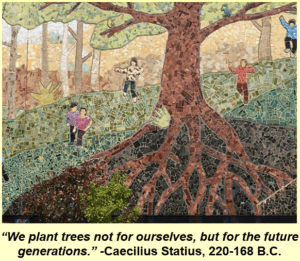 13 happens to be my lucky number. I want it to be lucky for you too.
13 happens to be my lucky number. I want it to be lucky for you too.
Today, I’m going to reveal to you how you can make this happen.
A recent survey of wills reported on by the Chronicle of Philanthropy reveals the average bequest by everyday donors is $78,630.
Some people will leave less; some people will leave more. What this survey reveals, however, is you only need 12 to 13 donors making a provision for your organization in their will to reap $1 million.
If a major gift for your organization is $1000 (or even 5000 or 10,000), I imagine this sounds off the charts to you. Guess what?
Legacy giving is off the charts!
In fact, bequest marketing produces the highest ROI (return on investment) of any fundraising activity.
The first step to making this happen for your organization is to encourage bequests. Actively.
Promote Charitable Bequests, or Else
If you don’t actively encourage charitable bequests, people are unlikely to make them.
Why? There are three primary reasons:
1. People are uncomfortable with their own mortality.
They just don’t like to think about it. At all.
Behavioral scientists call this “mortality salience.” People either willingly confront their mortality with an “approach” response. Or they run as far away as possible, simply not facing the fact it is part of the human condition. This is an “avoidance” response. Many, many people even neglect to make wills — roughly 66%!— because they don’t want to think about themselves dying. Someone has to suggest to them this might be a good idea, for any number of reasons – personal, financial, or charitable. It could be a friend or relative. It could be their attorney or financial advisor. Or it could be their friendly neighborhood nonprofit fundraiser (aka “philanthropy facilitator”).
2. Among people who do make wills, roughly 95% will not include a charitable bequest.
Most folks will listen to what their attorney recommends.
Sadly, many attorneys do not suggest charitable gifts. According to Dr. Russell James, the number of people in the United States age 55+ with a charitable estate beneficiary hovers between just 5% and 6%. Unless someone actively plants the seed that a charitable bequest is an opportunity worth considering, most folks simply miss out on this joyful legacy opportunity.
3. People may not know you accept legacy gifts.
Of course if you’re notified about a charitable bequest you’ll likely accept it.
But do your donors know that? It may seem obvious to you, but it’s never a good idea to assume donors know what you know. When they receive constant messaging from other charities they support asking them to consider making a bequest, but never receive any similar messaging from you, they may naturally assume this is not something you are set up for.
Nonprofits of All Sizes and Shapes Can Accept Bequests
I’ve actually heard legacy gifts called “major gifts for ordinary people.”
Because folks of any age or income level can, and do, leave legacy gifts. It’s a way to create a philanthropic autobiography. A way to leave a lasting mark on society. And these gifts tend to be the largest gifts these folks ever make – because they principally come from assets rather than just income.
It’s really not rocket science.
Honestly, you don’t need to set up anything special. When you’re notified by a lawyer, or family member, that a donor has made provision for your charity in their will, all you need to do is get in touch with them. Find out as much information as you can. Most important, find out when it’s expected the money will be distributed. Make a note on your calendar to get back to them if you haven’t heard from them by that date. Just stay on top of it so you assure the bequest really does end up coming to you, as per the donor’s wishes.
Know the Different Types of Bequests
It’s useful to understand different ways donors can make a charitable bequest. Essentially, there are three different types:
- Specific
- Residual
- Contingent
Specific bequest
With a specific bequest, the donor leaves a specified amount of money to your charity. According to a study by USLegalWills.com, the mean value of such bequests was $7000.
Residual bequest
With a residual bequest, the donor gives to charity everything that has not already been specifically bequeathed elsewhere. Often a residual bequest can be the largest gift the estate ends up making. This happens where the donor’s income and assets grow and appreciate more than they anticipated, and they’re able to distribute all the specific gifts they wanted to their family and still have more than enough left-over to constitute a significant charitable gift. In the USLegalWills.com study the medium value of such bequests was $200,000.
This is useful when a donor says to you: “I want to leave 5 million each to my son and daughter. I’m not sure there will be much left over, if any, after that.” You can then respond with: “I understand. In the event you do better than you anticipate, would you be comfortable making us the beneficiary of the residual of your estate? That way your kids will be taken care of, AND you’ll be able to enact some of your most cherished values long after you’re gone.”
Contingent bequest
With a contingent bequest, the donor leaves a gift to your charity that will only mature in the event something else does not happen. For example, they may leave their entire estate to their children if they predecease their kids; however, if their kids die before they do (this is a contingency), their entire estate will then go to you.
This is useful when a donor says to you: “I’m leaving everything to my family.” You can then respond accordingly: “Great! In the event your children predecease you, would you consider making our charity the contingent beneficiary? If you don’t, your entire estate will go to the government. Would you prefer to have your estate go there, or to come here and perhaps also go to other charities you currently support?”
Take a Broad-Based Approach
Look at numbers of participants in your legacy program, rather than just going after big gifts.
Remember, it only takes 12 – 13 donors to end up leaving your nonprofit $1 million. This is a numbers game as much as anything else. Plus, every one of those donors will end up feeling better about themselves as a result of thinking about perpetuating their values. Remember the MRI studies that show even contemplating making a gift gives a donor a “warm glow” dopamine rush that travels straight to their brain’s pleasure center. So think of promoting legacy giving as doing a good deed!
Look at people of various ages, not just “old people.”
It’s a myth that all gifts come from seniors. While people age 55+ do write the lion’s share of wills, they’re not the only ones. A recent study by Trust & Will revealed just 7% of Millennials had left bequests prior to this past year, but 17% cited the 2020 pandemic as a reason they decided to create an estate plan; 11% left money to charity.
Reaching people sooner has other benefits too.
One study by Dr. Russell James found people who have had charity consistently in their estate plan for the long-term (say, 10+ years before death) leave, on average, 4 times the amount left by those who first added a charitable component within two years of death.
Go for the “Lucky 13!”
In legacy giving, like all fundraising, you make your own luck.
Making people aware you value legacy gifts is the first step to getting them. Don’t forget to ask folks if they’d like to see their values live on. Legacy gifts don’t usually fall from the sky – unless you seed the clouds.
The research backs this up. More donors give, and they give more, when you ask them. Consider this:
- Donors surveyed by The Partnership for Philanthropic Planning found 70% of donors who made planned gifts did so because they were asked.
- Donors who received a letter directly asking them for a bequest were 17 times more likely to give a bequest than donors who were not asked.
All those ‘members’ your recruited to join your Legacy Society, of different ages and income levels, add up!
Want More?
 This coming Wednesday, March 24th, I’ll be offering a live session on “How to Talk about Legacy Giving Without Being Creepy.” It’s part of the 3-day virtual Nonprofit Summit: Being the Change beginning tomorrow, March 23, 2021 and offering amazing content from 30+ speakers. Even if you can’t attend, you can get the recordings — so check it out! It boils down to just about $7/session. Plus you get all sorts of rewards, a chance to win prizes and there’s even yoga, meditation, networking with peers and live comedy. Don’t miss out! Oh yes — you can even save $50 if you use my SPECIAL CODE: Claire50.
This coming Wednesday, March 24th, I’ll be offering a live session on “How to Talk about Legacy Giving Without Being Creepy.” It’s part of the 3-day virtual Nonprofit Summit: Being the Change beginning tomorrow, March 23, 2021 and offering amazing content from 30+ speakers. Even if you can’t attend, you can get the recordings — so check it out! It boils down to just about $7/session. Plus you get all sorts of rewards, a chance to win prizes and there’s even yoga, meditation, networking with peers and live comedy. Don’t miss out! Oh yes — you can even save $50 if you use my SPECIAL CODE: Claire50.






Excellent information. Thank you!